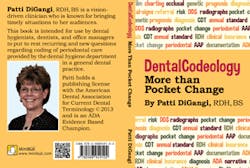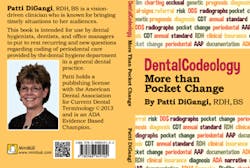Codes and the Barefoot RDH
by Lynne Slim, RDH, BSDH, MSDH
Unexpected things happen during a clinical day, and yesterday was no exception. I always begin my day by reviewing charts online. It was a day when I should have been wearing roller skates because my schedule was filled with kids and 30-minute appointments. It was a Monday, and I was sporting a new pair of shoes. Within minutes, as I prepared my operatory trays, my heels began to ache. I ignored it at first, but it only took about 30 minutes to realize that I had huge blisters on my heels. By the end of the first appointment, the blisters had ruptured and were bleeding.
I was in agony. So, what did I do? I worked barefoot part of the time, but please don't tell my infection control buddies such as Noel Kelsch, a fellow columnist! My daily schedule was full, and no one offered to drive to the store and buy me flip flops or even a pair of socks!
Just as shoes are an important part of personal protective equipment, so too is proper documentation of procedures by the clinical team. Patti DiGangi RDH, BS, emphasizes all of this and more in her new pocket-size book titled "DentalCodeology: More than Pocket Change." This convenient reference book is designed to fit in a pocket or be downloaded as an e-book. It covers four out of 13 CDT sections, and most of her discussions relate to the coding of periodontal care in a dental hygiene department.
------------------------------------------------
Other articles by Lynne Slim
- Resources for geriatric dementia
- Ask Lynne Slim: Leave the nerdy stuff about EBDH to me
- A lifetime of ‘leaning in'
------------------------------------------------
DiGangi has written many articles in RDH magazine. She not only thinks outside the box, but shakes it up as she goes along. In her book, for example, she explains that the legal definition of "standard of care" is the minimum level of acceptable professional conduct, and she gives it an academic grade of "C." Patti suggests that clinicians should focus more on diagnosis and documentation and less on telling patients what might be covered in their benefits package. Her bottom line reference is the American Academy of Periodontology (AAP) who reminds us that a treatment plan should be developed according to professional standards instead of provisions of dental plan contracts.
Not all of my columns are met with open arms, and they sometimes raise eyebrows. The same can perhaps be said for this book: portions of the book's content makes us think about what we're doing, and I'll highlight several suggestions that are timely and relevant.
- Certain periodontal terms have not been updated. An example that is pointed out in "DentalCodeology" is scaling and root planing. Nonsurgical debridement perhaps better describes hygiene instrumentation and accompanying antiseptic, local, or systemic therapeutics that are needed to reduce bacterial load and switch off inflammation.
- Documentation of gingivitis and periodontitis often lacks diagnostic information. Many dental practices document only probing depths. The AAP classifies gingival diseases into two major categories with many subclassifications and periodontal diseases into seven categories. Proper documentation includes a specific diagnosis that distinguishes health from gingival and periodontal diseases. In addition to a disease classification and diagnosis, case types, I-IV, should be recorded. There are no codes for care of active gingival diseases other than D4999 unspecified periodontal procedure, by report. DiGangi suggests throughout the book, Box 35 on the insurance report is for "remarks." Every claim should have a remark showing the medical necessity for the procedure.
- Comprehensive oral evaluations must include diagnosis and treatment planning, and DiGangi rightly points out that if you didn't record it, you didn't do it.
- Hygienists who are pressed for time (as many of us are due to improper scheduling) record baseline periodontal information by using the Periodontal and Recording System (PSR). Although this simplified system meets legal requirements, it does not meet the ADHA Standards of Clinical Dental Hygiene Practice (www.adha.org) and gets an academic grade of "F."
- The periodic oral evaluation code (D0120) is used most often by RDHs in clinical practice, but DiGangi points out that there is a high likelihood of fraud with this code, if necessary information is not recorded. Always check, measure, and record current conditions and look for changes when using this code.
- Risk assessment should be a routine part of periodontal evaluation but it takes time and is relatively new to the dental profession. Risk assessment is a method dental plan payers use to evaluate the predicted overall health-care claim dollars for each member relative to the average members of a given patient population. Risk assessment often determines how aggressively we treat disease, how often we take radiographs, recare frequency, and influences prescribed self-care measures.
- Major change is needed for when and why we take radiographs. This is a tough subject to broach because most (if not all) RDHs are taking radiographs, according to a pre-determined frequency. Changes in CDT 2013 included strong language about taking radiographic images for clinical reasons as determined by the dentist. In 2012, the FDA updated its radiographic recommendations and stated, "Radiographic screening for the purpose of detecting disease before clinical examination should not be performed." Benefit carriers, through utilization review, have begun to ask for documentation of the reason and result of radiographic images and sometimes claims are not paid as a result of improper documentation. DiGangi provides sample remarks/narratives for proper documentation of radiographic images. (Box 35 again, what is the medical necessity for the radiographs?)
- Referral to a periodontist should be thought of as co-patient management in certain cases, and evidence suggests that many periodontal patients would benefit from periodontal specialty care. DiGangi suggests establishing guidelines for referral to a periodontist. She presents referrals according to levels. Level 1 refers to patients who may benefit from referral such as those with diabetes and other complex medical histories like cancer or organ transplantation. Level 2 includes patients who would likely benefit from referral and co-management, such as patients with periodontal risk factors/indicators, early periodontal disease, unresolved inflammation at any site, or a deteriorating risk profile. Patients who should be treated by a periodontist, displaying severe chronic periodontitis, aggressive periodontitis or complex medical/dental challenges are considered level 3.
About a third of the pocketbook is devoted to case examples that give a detailed example of complex hygiene-related patient presentations and coding decision-making based on diagnosis and documentation. In giving you a sneak peek at DentalCodeology's content, I seriously recommend that you purchase a copy and either download it as an e-book or keep it handy in your operatory. 2015 will complicate matters even more as a new standardized vocabulary is developed for electronic record-keeping. Knowing Patti, she'll jump on this, too, like a flea on one of my dachshunds. Stay tuned for future DiGangi hygiene pocketbooks.
Just as conformity with personal protective equipment in an operatory matters, so does compliance with hygiene coding. This is important not only from a legal standpoint but also in consideration of minimizing patient out-of-pocket expenses and even more importantly, confirming that treatment is appropriate and necessary.
The book can be purchased at www.dentalcodeology.com and watch for Patti's CE courses coming to your area. RDH
LYNNE SLIM, RDH, BSDH, MSDH, is an awardwinning writer who has published extensively in dental/dental hygiene journals. Lynne is the CEO of Perio C Dent, a dental practice management company that specializes in the incorporation of conservative periodontal therapy into the hygiene department of dental practices. Lynne is also the owner and moderator of the periotherapist yahoo group: www.yahoogroups.com/group/periotherapist. Lynne speaks on the topic of conservative periodontal therapy and other dental hygiene-related topics. She can be reached at [email protected] or www.periocdent.com.

